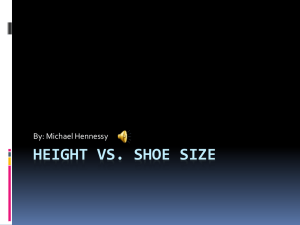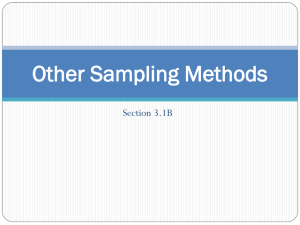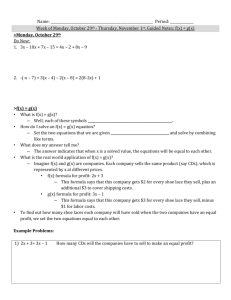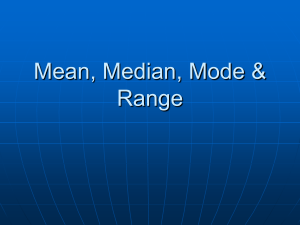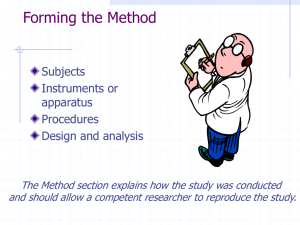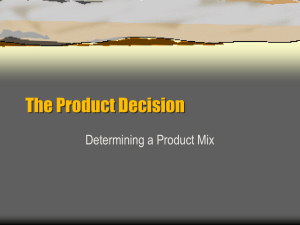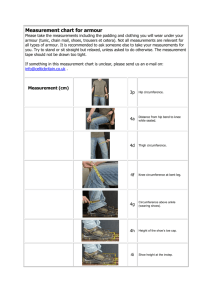1 - Pingry School
advertisement
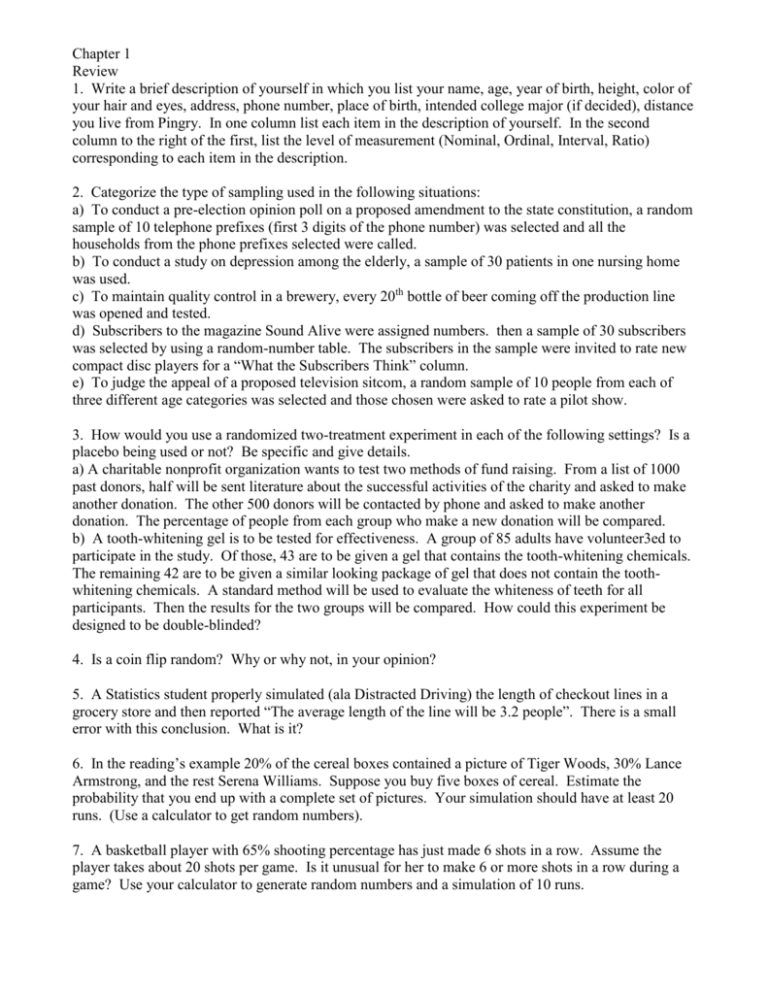
Chapter 1 Review 1. Write a brief description of yourself in which you list your name, age, year of birth, height, color of your hair and eyes, address, phone number, place of birth, intended college major (if decided), distance you live from Pingry. In one column list each item in the description of yourself. In the second column to the right of the first, list the level of measurement (Nominal, Ordinal, Interval, Ratio) corresponding to each item in the description. 2. Categorize the type of sampling used in the following situations: a) To conduct a pre-election opinion poll on a proposed amendment to the state constitution, a random sample of 10 telephone prefixes (first 3 digits of the phone number) was selected and all the households from the phone prefixes selected were called. b) To conduct a study on depression among the elderly, a sample of 30 patients in one nursing home was used. c) To maintain quality control in a brewery, every 20th bottle of beer coming off the production line was opened and tested. d) Subscribers to the magazine Sound Alive were assigned numbers. then a sample of 30 subscribers was selected by using a random-number table. The subscribers in the sample were invited to rate new compact disc players for a “What the Subscribers Think” column. e) To judge the appeal of a proposed television sitcom, a random sample of 10 people from each of three different age categories was selected and those chosen were asked to rate a pilot show. 3. How would you use a randomized two-treatment experiment in each of the following settings? Is a placebo being used or not? Be specific and give details. a) A charitable nonprofit organization wants to test two methods of fund raising. From a list of 1000 past donors, half will be sent literature about the successful activities of the charity and asked to make another donation. The other 500 donors will be contacted by phone and asked to make another donation. The percentage of people from each group who make a new donation will be compared. b) A tooth-whitening gel is to be tested for effectiveness. A group of 85 adults have volunteer3ed to participate in the study. Of those, 43 are to be given a gel that contains the tooth-whitening chemicals. The remaining 42 are to be given a similar looking package of gel that does not contain the toothwhitening chemicals. A standard method will be used to evaluate the whiteness of teeth for all participants. Then the results for the two groups will be compared. How could this experiment be designed to be double-blinded? 4. Is a coin flip random? Why or why not, in your opinion? 5. A Statistics student properly simulated (ala Distracted Driving) the length of checkout lines in a grocery store and then reported “The average length of the line will be 3.2 people”. There is a small error with this conclusion. What is it? 6. In the reading’s example 20% of the cereal boxes contained a picture of Tiger Woods, 30% Lance Armstrong, and the rest Serena Williams. Suppose you buy five boxes of cereal. Estimate the probability that you end up with a complete set of pictures. Your simulation should have at least 20 runs. (Use a calculator to get random numbers). 7. A basketball player with 65% shooting percentage has just made 6 shots in a row. Assume the player takes about 20 shots per game. Is it unusual for her to make 6 or more shots in a row during a game? Use your calculator to generate random numbers and a simulation of 10 runs. Chapter 1 Review For 8 and 9, identify a) the population b) the population parameter of interest c) the sampling frame d) the sample, e) the sampling method including whether or not randomization was employed and f) any potential sources of bias you can detect and any problems you see in generalizing to the population of interest. If you can’t tell, say so. This can happen when you read about a survey. 8. Researchers waited outside a bar they had randomly selected from a list of such establishments. They stopped every 10th person who came out of the bar and asked whether he or she thought drinking and driving was a serious problem. 9. A company packaging snack foods maintains quality control by randomly selecting 10 cases from each day’s production and weighting the bags. They open one bag from each case and inspect the contents. 10. In a large city school system with 20 elementary schools, the school board is considering the adoption of a new policy that would require elementary students to pass a test in order to be promoted to the next grade. The PTA wants to find out whether parents agree with this plan. Listed below are some of the ideas proposed for gathering data. For each, indicate what kind of sampling strategy is involved and what (if any) biases might result. a) Put a big ad in the newspaper asking people to log their opinions on the PTA Web site. b) Randomly select one of the elementary schools and contact every parent by phone. c) Send a survey home with every student and ask parents to fill it out and return it the next day. d) Randomly select 20 parents from each elementary school. Send them a survey and follow up with a phone call if they do not return the survey within a week. 11. For your poly-sci class, you’d like to take a survey from a sample of all the Catholic church members in your city. A list of churches shows 17 Catholic churches within the city limits. Rather than try to obtain a list of all members of these churches, you decide to pick 3 churches at random. For those churches, you’ll ask to get a list of all current members and contact 100 members at random. a) What kind of design have you used? b) What could go wrong with the design you have proposed? 12. Two members of the PTA Committee in problem 10 have proposed different questions to ask in seeking parents’ opinions: A: Should elementary school-age children have to pass high stakes tests in order to remain with their classmate? B: Should Schools and students be held accountable for meeting yearly learning goals by testing students before they advanced to the next grade? a) Do you think responses to these two questions might differ? How? What kind of bias is this? b) Propose a question with more neutral wording that might better assess parental opinion. 13. Examine the following questions for possible bias. If you think he question is biased, indicate how and propose a better question. a) Should companies that pollute the environment be compelled to pay the costs of cleanup? b) Given that 18 year olds are enough to vote and to serve in the military, is it fair to set the drinking age at 21? Chapter 1 Review For 14-17, read the report of statistical research and identify whether it was an observational study or an experiment. If it was observational, identify (if possible) a) whether it was retrospective or prospective b) the subject studied and how they were selected c) the parameter of interest. d) the nature and scope of the conclusion the study can reach If it was an experiment, identify (if possible) a) the subject(s) studied b) the factor(s) in the experiment and the # of levels c) the number of treatments d) the response variable measured e) the design (completely randomized, blocked or matched) f) whether it was blind or double blind g) the nature and scope of the conclusion the experiment can reach 14. Over a 4 month period, among 30 people with bipolar disorder, patients who were given a high dose (10g/day of omega 3 fats from fish oil improved more than those given a placebo. (Archives of General Psychiatry 56, [1999]: 407) 15. In a test of roughly 200 men and women, those with moderately high blood pressure (averaging 164/89 mm HG) did worse on tests of memory and reaction time than those with normal blood pressure. (Hypertension 36, [2000]: 1079) 16. Is diet or exercise effective in combating insomnia? Some believe that cutting out desserts can help alleviate the problem while others recommend exercise. Forty volunteers suffering from insomnia agreed to participate in a month-long test. Half were randomly assigned to a special no-desserts diet; the others continued desserts as usual. Half of the people in each of these groups were randomly assigned to an exercise program, while the others did not exercise. Those who ate no desserts and engaged in exercise showed the most improvement. 17. In 2002 the Journal Science reported that a study of women in Finland indicated that having sons shortened the life spans of mothers by about 34 weeks per son, but that daughters helped to lengthen the mothers’ lives. The data came from church records from the period 1640 to 1870. 18. A running shoe manufacturer wants to test the speed of its new springing shoe on the 100 meter dash times. The company sponsors 5 athletes who are running the 100 meter dash in the 2004 Summer Olympic Games. To test the shoe, they have all 5 runners run the 100 meter dash with a competitor’s shoe and then again with their new shoe. They use the difference in times as the response variable. a) Suggest some improvements to the design. b) Why might the shoe manufacturer not be able to generalize the results they find to all runners? 19. A 2001 Danish study published in the Archives of Internal medicine casts significant doubt on suggestions that adults who drink wine have higher levels of “good” cholesterol and fewer heart attacks. These researchers followed a group of individuals born at a Copenhagen hospital between 1959 and 1961 for 40 years. Their study found that in this group of adults who drank wine were richer and better educated than those who did not. a) What kind of study was this? b) It is generally true that people with high levels of education and nigh socioeconomic status are healthier than others. How does this call into question the supposed health benefits of wine? c) Can studies such as these prove causation? Explain. Chapter 1 Review 20. Recently, a group of adults who swim regularly for exercise were evaluated for depression. It turned out that these swimmers were less likely to be depressed than the general population. The researchers said that the difference was statistically significant. a) What does “statistically significant” mean in this context? b) Is this an experiment or an observational study? Explain. c) News reports claimed that this study proved that swimming can prevent depression. Explain why this conclusion is not justified by the study. Include an example of a possible confounding variable. d) But perhaps it is true. We wonder if exercise can ward of depression, and whether anaerobic exercise (like weight training) is as effective as aerobic exercise (like swimming). We find 120 volunteers not currently engaged in a regular program of exercise. Design an appropriate experiment. Chapter 1 Review Sources: B&B Chapter 1; BVD Chapters 2, 11, 12, 13
